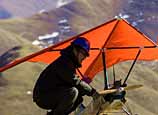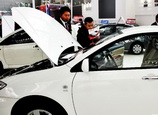
"Get off the road," an old man shouts as I swerve hopelessly along on my electric bike, avoiding an endless number of obstacles. At least, I assume that's what he was shouting, but given that he was speaking Chinese I actually had absolutely no idea. It could have been "you're a great driver", although the fleeing crowds of pedestrians directly in front of me make that possibility rather unlikely.
This is by now a typical scene: me, my e-bike, and China. A few weeks after arriving and experiencing the hellish crush of the subway a few times too many, I made the executive decision to purchase an e-bike, something mostly absent from the English roads.
I picked up a red beauty, finely proportioned and with the maximum possible speed (a hefty 40 km/h).
The bike was ideal. It wasn't too expensive and the prospect of nearly-free fuel was just too tempting to pass up. On top of this, I got to replace the claustrophobic melee of the subway with the feel of a gentle autumnal breeze on my face as I whizzed around town. I was also able to make friends with people by offering them "lifts".
For a while our relationship went smoothly, the e-bike and I. Although when I say "for a while", I actually mean precisely one day.
On the second day, with the wind in my sails, I planned an expedition to end all expeditions. Armed only with a bottle of mineral water and a makeshift map, I headed toward the city center. Little did I know, as I naively set off that October afternoon, just how disastrously things would turn out.
By 7 pm, having reached the center, I decided to head back. Shouldn't take longer than an hour, I reasoned, and my battery still had an estimated 30 km left. Yet, lo and behold, 5 minutes into my drive, my bike stuttered, shuddered and shimmied to a halt. Bemused, I hopped off and gazed around for a while. Then I tried the only recovery technique I have ever learned: turn it off and on again.
Shockingly, this most ancient and revered of strategies somehow failed. So there I was, entirely isolated in the middle of a Chinese city, with no idea precisely where I was, no Mandarin to speak of, and a map that, quite literally made no sense. Resolved to my fate, I slowly began to push my bike home - only 10 km or so. The bike, though, had other ideas. Mainly, its other idea was that it weighed about 3 tons, and didn't like being pushed around.
After half an hour of pushing (and about 100 meters of progress), I reached a hill. It seemed like all hope was truly lost. Yet, at what seemed like the very last minute, a middle-aged man appeared beside me.
He was also astride an e-bike, as old and worn-out as mine was new and enormous. Speaking no English, he simply gestured for me to grab onto his bike. So I did. What followed almost defies description. We whizzed through packed traffic - him confidently leading the way, me holding on for dear life, his e-bike stuttering like an abused mule.
As I clung to his bike like a child, leaning at a 45-degree angle to the road, I realized my foolishness. I was no match for these e-bikes. Finally, mysteriously, the man arrived at my home - how he knew where it was I have no idea, given that I had merely screamed "JINLING, JINLING".
He dropped me off, smiled, handed me a business card and drifted off into the night in an angelic fashion.
The next day, still dazed by the experience, I asked my Chinese friend what the business card said. "Aha," he smiled, "this man is a professional trombone player."
The story had reached new heights of absurdity. Yet now, whenever I hear the mournful howl of a trombone, I think back to that night, and the man who rescued one of the worst e-bike drivers in the history of China.
In spite of the many dangers and risks associated with e-bikes, they should clearly be introduced to English roads. Not only would this create a delightful version of the chaos that enlivens Chinese roads (and help the environment), but it would also give me an opportunity to one day repay my secret trombone Samaritan, by chancing upon another stranded e-bike apprentice, whom I could whisk safely home.














 Landmark building should respect the public's feeling
Landmark building should respect the public's feeling


![]()
